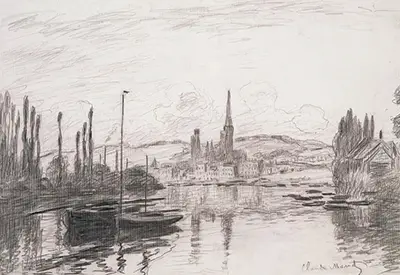Yet he was also an accomplished and talented draughtsman, drawing both as a preliminary to painting, and also as another medium in which to record previous work.
He drew with pencils, crayons and chalk throughout his life, and would make sketches of what he had already committed to canvas. In addition, as a young man he experimented successfully with caricatures, which are certainly not what art lovers expect from him today.
Monet's enthusiasm for Impressionism, painting outdoors or "en plein air" allowed spontaneous reactions. This preference led him to play down his involvement with any other medium or style, although many famous artists have sketched prior to committing themselves to canvas. Not surprisingly, J. M. W. Turner was an influence on Monet, and just like him, Claude would carry sketchbooks around with him.
The View of Rouen drawing was executed on a special textured support in 1883, on blued white Gillot paper. Nine years before this, Monet had exhibited some of his pastels in the first impressionist's exhibition in Paris (although the painters didn't use this term to describe themselves until their third show).
However, they are not shown in the catalogue, and were not reviewed by critics either. In this modestly-sized drawing (31.3 cm by 47.5 cm), black chalk or graphite was used to interpret an 1872 work in oil on canvas of the same scene, in order to reproduce it in print. Transferred to a zinc plate by photomechanic means, the loops and zigzags combined with the surface grooves to produce a tonal finish. This can be seen quite clearly by zooming in on the image.
The well-known landmark of Notre Dame de l'Assomption dominates the background, as it still does today. This is a city of spires but the cathedral can boast that it possesses the highest in France. The river Seine flows smoothly in the foreground, leading the viewer into the urban scene beyond.
Unoccupied small boats are moored near the banks, with a boat shed or hut on the right-hand side, and poplars lining the verges, so that the nearest part of the drawing suggests serenity. It is left to the imagination to dive into the bustle of the elegant Norman town in the distance, with the reflections in the water linking the beginning and end of the picture.
Later, he went on to produce over thirty paintings of Rouen cathedral in 1892 and 1893, reworking them the following year in his studio. The Gothic-style building is depicted at different times of day, in all seasons and in every kind of light. The earlier drawing of 1883 was done in the same year that the family moved to Giverny, where Monet also indulged his interest in repeating the same subject matter as it became affected by changing light.
Highlights from the artworld to have followed on after the achievements of the impressionists include The Dream by Pablo Picasso, Angelus Novus by Paul Klee and False Mirror by Rene Magritte.
Claude Monet, born as Oscar in 1840, lived until 1926, so he had plenty of time to develop his style and to experiment, in an age of constant change and innovation. This line-drawn View of Rouen is deceptive in its simplicity, and it is a shame that the artist sought to play down his skills in this area. Until comparatively recently, these sketches weren't well known, but now Monet fans are able to judge for themselves.


